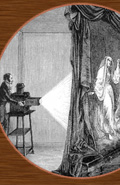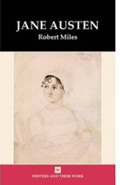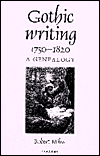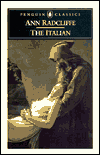Dr. Robert Miles

Position
Contact
Credentials
BA (Simon Fraser), MA (London), PhD (Sheffield)
Area of expertise
Romanticism; the eighteenth century; 19th century British literature
Before arriving at UVic Robert Miles was Professor and Chair at the Universities of Stirling and Sheffield Hallam in the UK. He is a past president of the International Gothic Association.
His teaching interests include Nineteenth Century English and American Romanticism, the Romantic-era Novel, Gothic Writing and Jane Austen.
He has published in the journals Studies in Romanticism, Eightenth-Century Fiction, The Eighteenth-Century: Theory and Interpretation, Novel: A Forum on Fiction, Gothic Studies, Essays and Studies, Women's Writing: The Elizabethan to Victorian Period, ELH and Texas Studies in Literature and Language.
Selected publications
Romantic Misfits
Palgrave Studies in the Enlightenment, Romanticism and the Cultures of Print
Romantic Misfits is an acute and searching account of a linked sequence of authors and literary episodes that centrally challenges and troubles much that is familiar about the history of Romantic writing in Britain. Its originality lies in the way it conceives these false starts and disturbances - 'misfits' and misfittings - as both a constitutive challenge to canonical romanticism and a distinctive literary field worth examining on its own account. Its misfits include the Shakespeare forger W.H. Ireland, Wordsworth's early gothic, Coleridge's material imagination, the novel itself, and the culture of Dissent.
Gothic Technologies: Visuality in the Romantic Era

Romantic Circles Praxis Series: http://www.rc.umd.edu/praxis/
This volume of Romantic Circles Praxis Series includes an editor's introduction by Robert Miles and essays by Fred Botting, Diane Long Hoeveler, Sophie Thomas, Dale Townshend, and Angela Wright.
Gothic Technologies explores the relationship between Romantic Gothicism and the rise of the visual technologies centred on commercial exploitation of the magic lantern. Although grounded in the technological innovations of the Romantic and early Victorian periods and reactions to them the essays in the collection anticipate modern attitudes towards visuality, developing the link between the rise of literary Gothic and subsequent visual technologies.
Jane Austen: Writers and their Work

Northcote House Publishers Ltd, 2003
By assessing what was original in Jane Austen's fictional technique in the context of the history of the novel, Robert Miles takes a fresh look at how Austen came to be constructed as a model of Englishness. For many readers Jane Austen is the quintessential English author. Jane Austen sets out to explore the history of this identification with Englishness in the context of a tradition of criticism that has frequently tried to achieve the reverse: to establish her difference, and distance, from 'us'. Rather than simply showing how Austen differs from the heritage, Jane Austen argues that many of the reasons for her construction as an English cultural icon are to found in the works formal qualities, and often in her most innovative techniques.
Gothic Writing, 1750-1820: A Genealogy

Manchester University Press; New edition (2002)
In this provocative study, Robert Miles uses the tools of modern literary theory and criticism to analyze this very distinctive body of text. Miles introduces the reader to contexts of Gothic in the 18th Century, including its historical development and its placement within discourse and gender concerns of the period. By drawing extensively on the ideas of Michel Foucault to establish a genealogy, he brings Gothic writing in from the margins of 'popular fiction', resituating it at the center of debate about Romanticism.
Ann Radcliffe: the Great Enchantress

Manchester University Press; 1995
To her contemporaries, Ann Radcliffe was "The Great Enchantress". Her wild and stormy Gothic romances made her one of the most popular and successful writers of the late-18th century. This is an introduction to her life and work, written especially for first- and second-year undergraduate students of literature and culture. Radcliffe was lampooned by many for the excesses of her writing - the craggy mountains, gloomy forests, ghosts, orphans, fainting heroines, fantastic resolutions - and yet her influence was felt across England and throughout Europe. The 1790s was a time of great social and political upheaval and Miles argues that Radcliffe should be read not as a conservative writer, but one who creatively renders visible the power structures of her time, place, gender and class. This work is intended for all students of the period and for anyone interested in the Gothic genre and women's writing.
The Italian

Penguin Group (2001); Robert Miles, editor.
First published in 1797, The Italian is one of the finest examples of Gothic romance. The fast-paced narrative centres on Ann Radcliffe's most brilliant creation, the sinister monk Schedoni, whose past is shrouded in mystery. From the opening chapters the reader is ushered into a shadowy world, in which crime and religion intermingle. Leagued against Ellena Rosalba and Vincentio di Vivaldi's union are the proud and ambitious Marchese di Vivaldi and her confessor Father Schedoni. Supernatural forces seem at work, but it is to the Holy Inquisition that the ill-omened lovers eventually fall prey. This edition explores the work in the context of British attitudes to Italy and Roman Catholicism in the late eighteenth century, as well as providing close analysis of the novel's structure and form.
